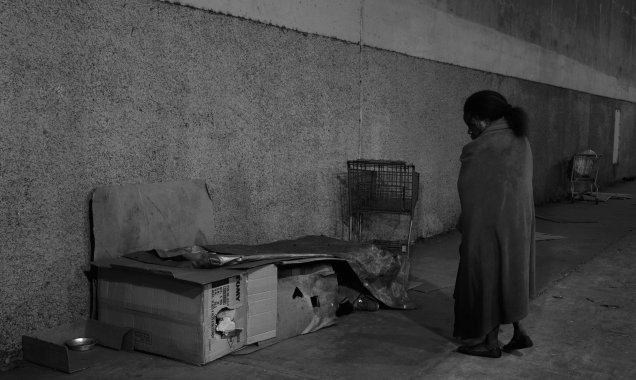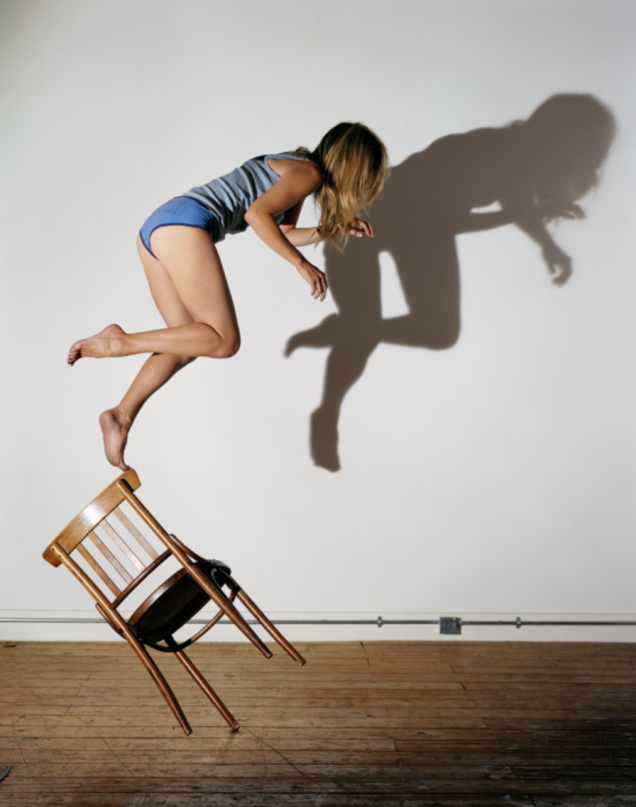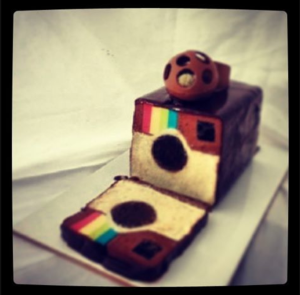In considering both practice and editing for my Work in Progress Portfolio, Informing Contexts, I sought out a way of dealing with a rule and an exception
I have been struck by the need to analyse and therefore explain my decision to not only photograph ‘people-free’ but in particular to make an editing decision to show the trace of humanity. But with an exception.
The creative process is about intent but also about revelation. So, having sought out a theme for my work on the MA course which commenced as an overarching title ‘re-seeing’ it initially developed into a piece on public art and its crafted quality (the hand of the maker was manifestly what I was inclined to show) but moved on into the hand of the architect and maker in creating buildings in the mid-twentieth century that had been deemed to be at the end of their useful life. I know all too well that to develop a building from an idea to a fully fledged investment and commitment to complete is an Herculean effort. So to see these at the end of life is an undeniably emotional downer.
Yet there is another emotion at play. This begins to open out a personal, reflective space. 2016 was quite a moments year for me, I made the decision that corporate leadership was not such fertile territory and I needed to define a period that I call, at least to myself, a break. I was drained and tired. Spliced into this was dealing with the loneliness of being the eponymous singleton. The title and status had for years synchronised. How to deal with these two things? Well a break meant downing the management tools, but nothingness was not the answer to the loneliness. So I embarked on the journey to learn, to provoke myself, to move my critical faculties away from architecture and apply then to a new realm. That newness is about photography, about making, undertaking, theorising and critiquing. At the end of the second module of my MA course I feel armed in all of these new faculties. Sure, there is more to explore, more learning to do, but there is tangible discovery and there is definition. But, as I tap away on Easter Sunday, alone with just my dog who is gently wagging his tail on the sofa in his canine dream world, I am having a realisation;
I like to be around people, just a few, never a crowd. I love talking, I like to laugh, I listen too. The socialisation of my MA crew has been key to my own emotional stability, yet yet yet; so many many of my counterparts are dealing with the images of relationships in one form or another, whether intimate or socially at scale. I am not. I perambulate around spaces, looking for light, shadow, doorways, windows, texture, marks, scrapes, patterns, dust, detritus, looming and lurking. It is just me. Indeed, perhaps I wear black to reduce personal impact and visibility. Like Jeff Wall’s octopus in a corner.
I ask myself the question, is it easier not photographing people? To a degree it is, there is no relationship to develop, nurture and convey with a ‘subject’. But actually, it is just different; I am developing my eye for the space, place and moment of light, of a feel for how a detail conveys a whole; for human touch and trace. This is deepening and becoming more regular, this photographer’s eye is not a generalist it is becoming a specialist.
Practice
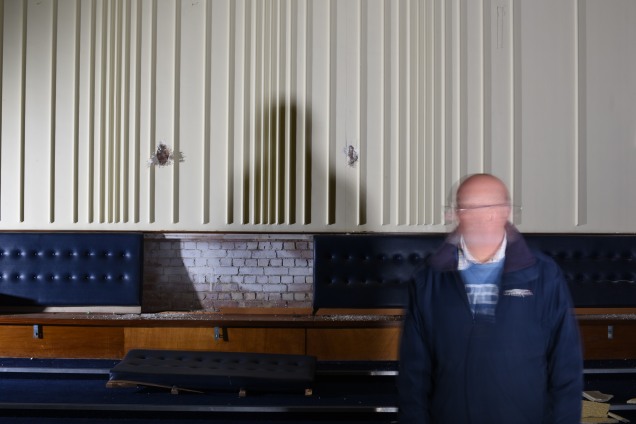
figure1
I was joined by a mason when making images of the redundant and vacant masonic hall in Birmingham. He was able to really help me understand the use and meaning of all the spaces and demystify some of the secrecy and processional procedures. So, I decided to photograph him in the very inner ‘temple’ space. The space was actually less precious and distinctive than I expected, fitting the banal I was seeing throughout the complex, so I made an exception to my rule, I asked him to move through the space as I exposed on the tripod. He was happy to be photographed, but I wanted to suggest in the image my view that people in this faceless, windowless building should be similarly asked to preserve some blurred anonymity; he, as the subject was happy with this. After a few attempts, this is the photograph, figure 1. I pondered its inclusion into my series Empty. It did not make it into the penultimate edit. If I were to make a photobook of the masonic experience it would probably be included, but in the Empty series it seemed distracting and adding little to the hollow content I was wishing to capture.
So, why, after this inner debate and clarity, is there a man in the last image in my final edit of Empty? See figure 2. Well, here are my reasons. The man in question is absolutely central to the image and all to the purpose of St Thomas More’s church. I had spent the whole morning there since just after dawn when the church doors open. Mass started two hours later and I vacated the building for the duration. That moment struck. There was the priest administrating, standing under the ‘chimney’ at the crescendo of the structure which shafted light down onto the alter area, viewed through a glass door, itself the inner door of the lobby to the outer solid doors, themselves beyond the concrete structure. The layering of space and image that I really seek out, was all there. This building was the only one in constant and persistent use, despite its threatened status. It has been the exception to prove my rule. It also served as a finale image where I look in; a counterpoint to the opening image which is about looking out, here is a sneaky look in.
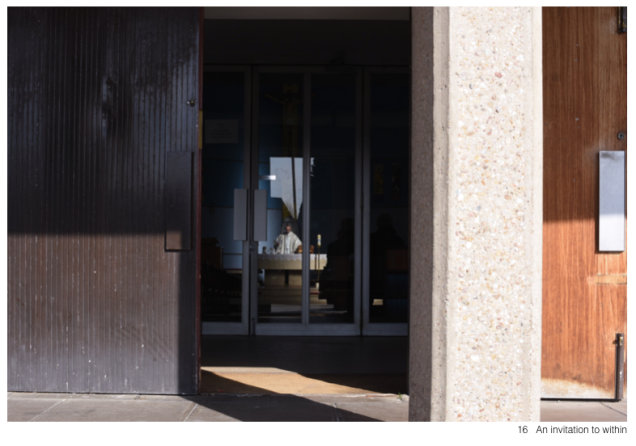
figure 2
The Practice of Others
The interview with the photographer Todd Hido in Ahorn magazine in the archive http://www.ahornmagazine.com/issue_6/interview_hido/interview_hido.html (accessed on 16th April 2017) is revealing and appropriate here.
He is known for capturing American landscapes and the human imposition. he shoots at dusk, with film, using found light to capture the stillness, the place but also the light emitting from interiors, the sign, the index of occupation, of life; implied not visible. It is a suburban ordinariness at small scale. Yet there is one house where no light comes from within, as the interviewer asks “The image “Untitled #2312-a, 1999” from the series Houses at Night is one of the few images without a visible illumination coming from the house. A beam of light cuts the front of the house but no light comes from the inside. In every house you have photographed the human presence is implied. The quality of the light is also the quality of their presence. Thanks to this perception, you are able to establish a relationship between the viewer and the image, as a personal relationship. Could you explain something more about this particular choice? How important is it for your work to show inhabited houses with human beings’ presence instead of empty houses?” See figure 3.
Hido responds, “You are very perceptive. Yes, that is the only house at night that does not have a light on the window. I chose that particular one because it was actually a place that a lot of my ideas about home and loss and longing came to fruition. What I found was really remarkable to me as it was a neighborhood that had simply been walked away from my many of its inhabitants.” He continues very usefully to explain his feeling and practice “Yes, it’s true that most of my photographs of homes at night have a light on in the window. That is a very important part to me as it implies that someone is in there. I have often said; “The lights come on and the inside seeps to the outside.””

figure 3
What fascinated me on reading Hido further is that he often manages to find his way into homes and here is his observation in response to this question “You frequently have photographed interiors. How did you find the places, do some of them have a special meaning for you?”
Hido responds “Yes, I love to photograph interiors. They often add another layer of narrative to a sequence of photographs. And I really like what that does—it sort of brings the viewer inside of the home”. See figure 4.
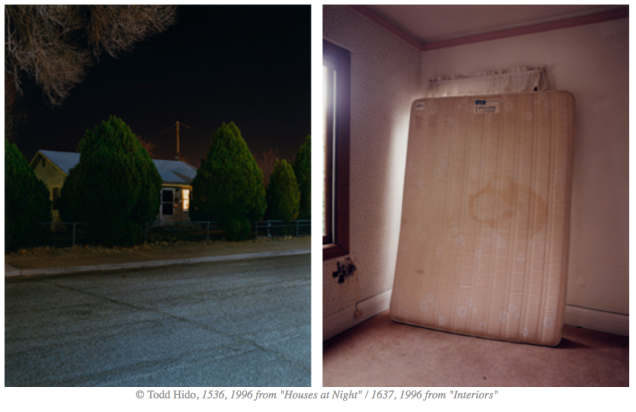
figure 4
Summary
My practice is a sort of inverse of Hido. He finds light as a source of life; I find emptiness as a source of life dissipated. His edited exception is a lifeless house captured via its setting and architecture; my edited exception is one of life at the core of a purposeful architecture. Hence the inverse.
Yes Hido’s emotional stance, his feelings for loss and longing are very much the centre of practice. He finds human trace, so do I. There is a commonality alongside the inverse.
